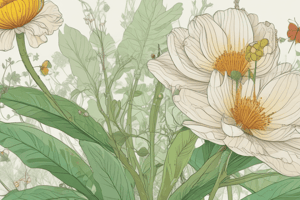Podcast
Questions and Answers
What is fertilization in flowering plants, and where does it occur?
What is fertilization in flowering plants, and where does it occur?
Fertilization is the fusion of male and female gametes (sperm and egg cells) to form a zygote, and it occurs in the embryo sac of the ovule.
What is the purpose of pollination in the fertilization process of flowering plants?
What is the purpose of pollination in the fertilization process of flowering plants?
The purpose of pollination is to transfer pollen grains from the anther to the stigma.
Describe the process of sperm cell release in the fertilization process of flowering plants.
Describe the process of sperm cell release in the fertilization process of flowering plants.
The pollen tube releases two sperm cells into the embryo sac.
What is unique about the fertilization process in flowering plants, and what is its significance?
What is unique about the fertilization process in flowering plants, and what is its significance?
What is the role of the endosperm in the fertilization process of flowering plants?
What is the role of the endosperm in the fertilization process of flowering plants?
What is the significance of fertilization in ensuring genetic variation in offspring?
What is the significance of fertilization in ensuring genetic variation in offspring?
What is the primary difference between self-pollination and cross-pollination?
What is the primary difference between self-pollination and cross-pollination?
How do birds and bats contribute to pollination?
How do birds and bats contribute to pollination?
What is the role of pollen production in the pollination process?
What is the role of pollen production in the pollination process?
How do plants adapt to attract pollinators?
How do plants adapt to attract pollinators?
What is the significance of pollination in food security?
What is the significance of pollination in food security?
What is the role of wind in pollination?
What is the role of wind in pollination?
How does pollination affect the reproduction of flowering plants?
How does pollination affect the reproduction of flowering plants?
What is the relationship between pollination and fertilization in flowering plants?
What is the relationship between pollination and fertilization in flowering plants?
Study Notes
Fertilization in Flowering Plants
Definition and Process
- Fertilization is the fusion of male and female gametes (sperm and egg cells) to form a zygote.
- In flowering plants, fertilization occurs in the embryo sac of the ovule.
Steps Involved in Fertilization
- Pollination: Transfer of pollen grains from the anther to the stigma.
- Germination of pollen grain: Pollen grain absorbs water and swells, leading to the formation of a pollen tube.
- Pollen tube growth: The pollen tube grows down through the style and into the ovary.
- Sperm cell release: The pollen tube releases two sperm cells into the embryo sac.
- Fusion of sperm and egg cells: One sperm cell fuses with the egg cell to form a zygote.
- Formation of endosperm: The second sperm cell fuses with the central cell to form the endosperm, which nourishes the developing embryo.
Double Fertilization
- A unique feature of flowering plants, where two sperm cells are involved in fertilization.
- One sperm cell fertilizes the egg cell, while the other fertilizes the central cell to form the endosperm.
Importance of Fertilization
- Ensures genetic variation in the offspring.
- Leads to the formation of seeds, which are essential for plant reproduction and dispersal.
Fertilization in Flowering Plants
Definition and Process
- Fertilization is the fusion of male and female gametes to form a zygote, occurring in the embryo sac of the ovule.
Steps Involved in Fertilization
- Pollination occurs through the transfer of pollen grains from the anther to the stigma.
- A pollen grain absorbs water, swells, and forms a pollen tube.
- The pollen tube grows down through the style and into the ovary.
- Two sperm cells are released into the embryo sac through the pollen tube.
- One sperm cell fuses with the egg cell to form a zygote.
- The second sperm cell fuses with the central cell to form the endosperm.
Double Fertilization
- A unique feature of flowering plants, where two sperm cells are involved in fertilization.
- One sperm cell fertilizes the egg cell, while the other fertilizes the central cell.
Importance of Fertilization
- Ensures genetic variation in the offspring.
- Leads to the formation of seeds, essential for plant reproduction and dispersal.
Pollination
- Pollination is the transfer of pollen from the male reproductive organ (anther) to the female reproductive organ (stigma) of a flowering plant, allowing for fertilization to occur.
Types of Pollination
- Self-Pollination occurs within the same flower or between flowers of the same plant.
- Cross-Pollination occurs between flowers of different plants.
Agents of Pollination
- Insects such as bees, butterflies, moths, and wasps are common pollinators.
- Wind carries pollen from one plant to another.
- Some birds, such as hummingbirds, transfer pollen while feeding on nectar.
- Some species of bats, such as fruit bats, pollinate plants.
Pollination Process
- Anther produces pollen grains.
- Pollen is released from the anther.
- Pollen is transferred to the stigma by an agent of pollination.
- A pollen grain germinates and fertilizes the egg cell in the ovary.
Importance of Pollination
- Pollination is necessary for seed production.
- Pollination is necessary for fruit production.
- Pollination is essential for food security, as many crops rely on pollination for reproduction.
Pollination-Related Adaptations
- Bright colors and patterns on flowers attract pollinators.
- Nectar production attracts pollinators.
- Specific shapes and structures of flowers guide pollinators towards the reproductive organs.
- Fragrances attract pollinators.
Studying That Suits You
Use AI to generate personalized quizzes and flashcards to suit your learning preferences.
Description
Learn about the process of fertilization in flowering plants, including pollination, germination of pollen grain, and pollen tube growth. Understand the formation of a zygote and the role of embryo sac in the ovule.




